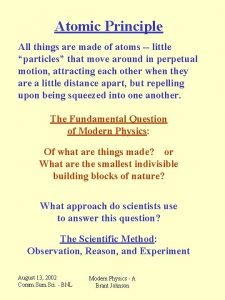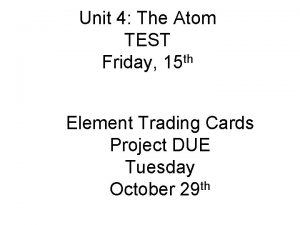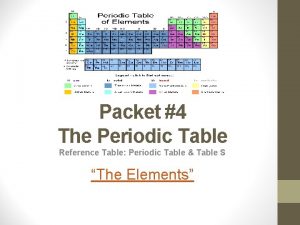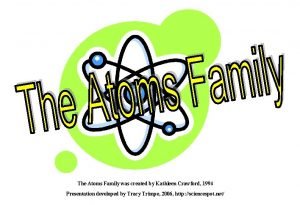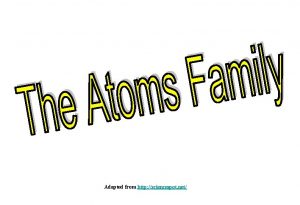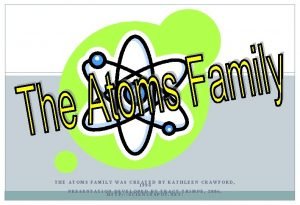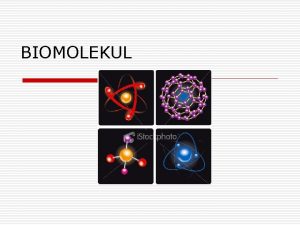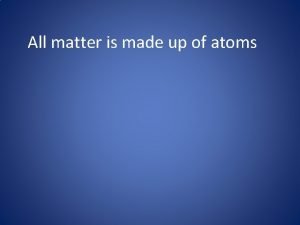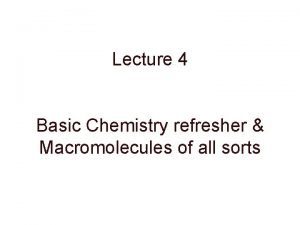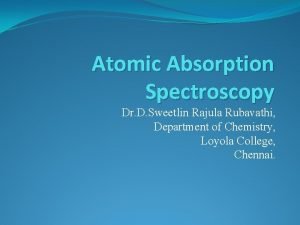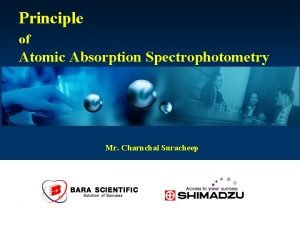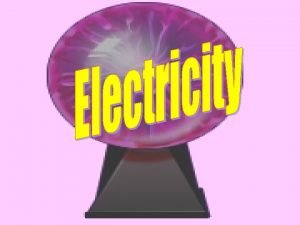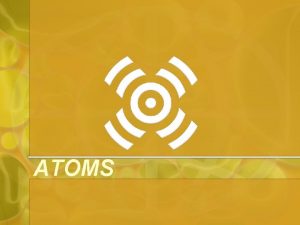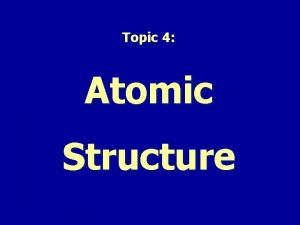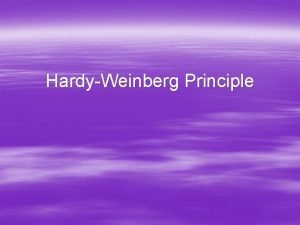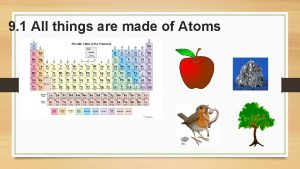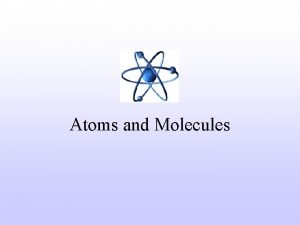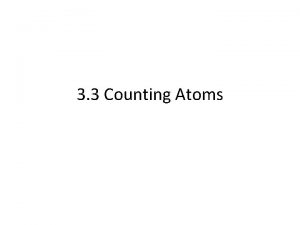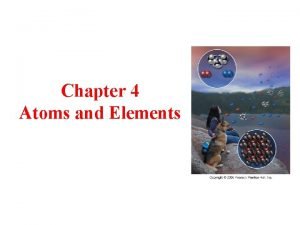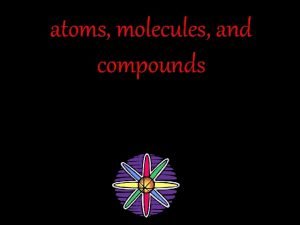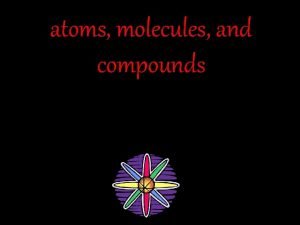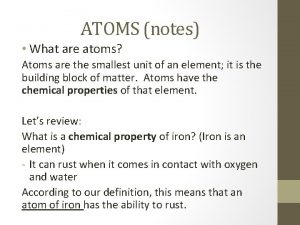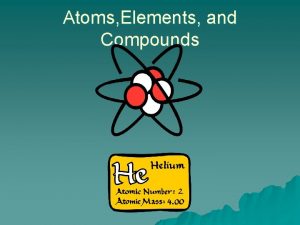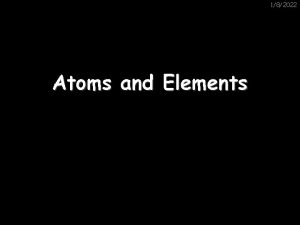Atomic Principle All things are made of atoms





























- Slides: 29

Atomic Principle All things are made of atoms -- little “particles” that move around in perpetual motion, attracting each other when they are a little distance apart, but repelling upon being squeezed into one another. The Fundamental Question of Modern Physics: Of what are things made? or What are the smallest indivisible building blocks of nature? What approach do scientists use to answer this question? The Scientific Method: Observation, Reason, and Experiment August 13, 2002 Comm. Sum. Sci. - BNL Modern Physics - A Brant Johnson

Things that we know today about ATOMS 1. Very small (about 0. 1 nm across) 2. Stable (atoms can last forever) 3. Electrically Neutral (no net charge) 4. Emit and Absorb Light (at discrete wavelengths and energies) August 13, 2002 Comm. Sum. Sci. - BNL Modern Physics - A Brant Johnson

[ Inserted here are plastic slides: History of devel. of atomic models: Hard sphere, plum pudding, Bohr’s planetary model, quantum mechanics Along the way: wave-particle duality, complimentarity, correspondence principle, uncertainty ] August 13, 2002 Comm. Sum. Sci. - BNL Modern Physics - A Brant Johnson

Wave-Particle Dualism Experiments have shown that things we usually think of as waves also act like particles and that things we usually think of as particles also act like waves. Light Wave Photon Electron Wave Electron This does not mean that all things are WAVICLES Electrons in atoms are either 100% particles or 100% waves. Electrons are never both waves and particles at the same time. August 13, 2002 Comm. Sum. Sci. - BNL Modern Physics - A Brant Johnson

Principle of Complimentarity No single experiment can simultaneously show both the wave and particle aspects of anything. Quantum Mechanics Quotes Bohr said that if you aren’t confused By quantum mechanics, then you Haven’t really understood it -- J. Wheeler Boolean logic is based on either-or propositions. Quantum mechanical logic is non-Boolean. -- J. Bub August 13, 2002 Comm. Sum. Sci. - BNL Modern Physics - A Brant Johnson

More Quantum Quotes God does not play dice with the universe. – A. Einstein It is not the job of scientists to prescribe to God how He should run the world. – N. Bohr Einstein said that if quantum mechanics is right, then the world is crazy … Well, Einstein was right. The world is crazy. – D. Greenberger Most physicists are very naive; most still believe in real waves or real particles. – A. Zeilinger August 13, 2002 Comm. Sum. Sci. - BNL Modern Physics - A Brant Johnson

Even More Quantum Quotes Quantum phenomena are neither waves nor particles, but are intrinsically undefined until the moment they are measured. -- J. Wheeler The quantum state reflects not only what we know about the system, But what is in principle knowable. -- P. Mandel All of these QM quotes are taken from “Quantum Philosophy” by John Horgan in the July 1992 issue of Scientific American, pages 94 -102. August 13, 2002 Comm. Sum. Sci. - BNL Modern Physics - A Brant Johnson

“… I think I can safely say that nobody understands Quantum Mechanics. ” Richard Phillips Feynman (1918 -1988), an American physicist contributed to the joining of relativity and quantum theory with electromagnetism to form quantum electrodynamics. He is also known for his reformulation of quantum mechanics and his research on liquid helium. In 1965 he shared the Nobel Prize for physics with Julian Schwinger and Sin Itiro Tomonago for their contributions to electrodynamics. August 13, 2002 Comm. Sum. Sci. - BNL Modern Physics - A Brant Johnson

Classical Physics Concepts Conservation of Energy & Momentum Continuous Energy (E=½ mv 2) Waves are Waves Particles are Particles Real Stuff is made of particles Position & velocity are both known precisely. Quantum Mechanics Concepts Conservation of Energy & Momentum Energy comes in discrete units (quanta) Energy is related to wavelength (E=hc/l) Wave-Particle Duality (Complimentarity) Stuff is neither real waves nor real particles Heizenberg Uncertainty Principle: (e. g. , both position and velocity cannot be known to better than Plancks constant) Correspondence Principle August 13, 2002 Comm. Sum. Sci. - BNL Modern Physics - A Brant Johnson

Classical Physics Concepts Conservation of Momentum Conservation of Energy Conservation of Mass Conservation of Dimensions (e. g. , length) Universal Time Special Relativity Concepts Conservation of Momentum Conservation of Energy Mass related to energy ( E = mc 2 ) Length Contraction as velocity approaches c Personal Time (Twins Paradox) August 13, 2002 Comm. Sum. Sci. - BNL Modern Physics - A Brant Johnson

August 13, 2002 Comm. Sum. Sci. - BNL Modern Physics - A Brant Johnson

Personal Time Assume space ship moves left to right at 0. 8 c. Due to the motion of the space ship relative to earth, the two observers will disagree about the distance the light has traveled. Because the speed of light is the same for all observers, they must therefore disagree about the time the light has taken to travel back and forth. That is, they each have their own “personal time. ” August 13, 2002 Comm. Sum. Sci. - BNL Modern Physics - A Brant Johnson

Twin Paradox The twin traveling in the space ship will age more slowly than his brother who remains on earth August 13, 2002 Comm. Sum. Sci. - BNL Modern Physics - A Brant Johnson

Momentum and Energy What is momentum? Classical: p = m v Quantum: p = h / l Relativistic: p = g m 0 v What is Energy? Classical: E = 1/2 m v 2 Quantum: E = h c / l Relativistic: E = m c 2 = g m 0 c 2 where, v = speed of “particle” c = speed of light m = mass; h = Planck’s constant l = wavelength g = 1 / SQRT ( 1 – b 2); b = v / c August 13, 2002 Comm. Sum. Sci. - BNL Modern Physics - A Brant Johnson

Small, smaller, … smallest? August 13, 2002 Comm. Sum. Sci. - BNL Modern Physics - A Brant Johnson

Nuclear Physics August 13, 2002 Comm. Sum. Sci. - BNL Modern Physics - A Brant Johnson

Relativity and Fission The total mass of a nucleus is not equal to the sum of its proton and neutron masses. The difference is the nuclear binding energy E = m c 2. An incoming neutron causes the U-235 nucleus to break apart. Neutrons (n) can initiate a chain reaction, because on average each incident neutron causes the release of 2. 4 neutrons and 215 Me. V of energy. August 13, 2002 Comm. Sum. Sci. - BNL Modern Physics - A Brant Johnson

August 13, 2002 Comm. Sum. Sci. - BNL Modern Physics - A Brant Johnson

Elements Atomic Mass (A) = total number of protons plus neutrons Atomic Number (Z) = number of protons (p) August 13, 2002 Comm. Sum. Sci. - BNL Neutron Number (N) = number of neutrons (n) Modern Physics - A Brant Johnson

More about the Elements Light elements usually have the same neutron number (N) of neutrons (n) as protons; heavier elements have more. August 13, 2002 Comm. Sum. Sci. - BNL Modern Physics - A Brant Johnson

Many isotopes are unstable. These emit radiation; and are said to be radioactive nuclei August 13, 2002 Comm. Sum. Sci. - BNL Modern Physics - A Brant Johnson

August 13, 2002 Comm. Sum. Sci. - BNL Modern Physics - A Brant Johnson

Some forms of radioactive decay change the atomic number (Z) or mass (M) of the primary nucleus August 13, 2002 Comm. Sum. Sci. - BNL Modern Physics - A Brant Johnson

Three forms of radioactive decay. Alpha - Nucleus of normal He isotope; two p and two n (charge = +2). Beta - Electron (charge = -1) Gamma - Photon (particle of light) called gamma-ray from nucleus, or x-ray from atom. August 13, 2002 Comm. Sum. Sci. - BNL Modern Physics - A Brant Johnson

The ABC’s of Nuclear Science http: //www. lbl. gov/abc/ The Nuclear Science Wall Chart and tour of Nuclear Science August 13, 2002 Comm. Sum. Sci. - BNL Modern Physics - A Brant Johnson

Quarks August 13, 2002 Comm. Sum. Sci. - BNL Modern Physics - A Brant Johnson

Quarks and Leptons August 13, 2002 Comm. Sum. Sci. - BNL Modern Physics - A Brant Johnson

Beta Decay A neutron is “converted” into A proton and a down quark becomes an up quark. The virtual W- boson decays into an electron and an anti-electron neutrino. August 13, 2002 Comm. Sum. Sci. - BNL Modern Physics - A Brant Johnson

Relativistic Heavy-Ion Physics Classified as Nuclear Physics, but has considerable overlap with Particles and Fields (High Energy) Physics. Stay tuned for tomorrow’s lectures about the Relativistic Heavy-Ion Collider (RHIC) August 13, 2002 Comm. Sum. Sci. - BNL Modern Physics - A Brant Johnson
 Are all things made of atoms
Are all things made of atoms Insidan region jh
Insidan region jh Compared to atoms of metals, atoms of nonmetals generally
Compared to atoms of metals, atoms of nonmetals generally The 7 life processes of all living things
The 7 life processes of all living things Matterville answer key
Matterville answer key Which compound contains an alkali metal and a halogen
Which compound contains an alkali metal and a halogen The atoms family song
The atoms family song Matterville worksheet
Matterville worksheet The atom family atomic math challenge
The atom family atomic math challenge Matterville answer key
Matterville answer key Bagian terkecil dari polimer adalah....
Bagian terkecil dari polimer adalah.... Are cells made up of atoms
Are cells made up of atoms Is atomic mass and relative atomic mass the same
Is atomic mass and relative atomic mass the same What are the trends on the periodic table
What are the trends on the periodic table Atomic radius increases when
Atomic radius increases when How to calculate abundance in isotopes
How to calculate abundance in isotopes Atomic
Atomic Atomic number vs atomic radius
Atomic number vs atomic radius Name a line containing point a
Name a line containing point a What makes up the atomic mass
What makes up the atomic mass Chapter 5 lesson 1 health
Chapter 5 lesson 1 health All about atoms
All about atoms Principles of atomic emission spectroscopy
Principles of atomic emission spectroscopy Advantages and disadvantages of spectroscopy
Advantages and disadvantages of spectroscopy Principle of absorption
Principle of absorption Atomic fluorescence spectroscopy principle
Atomic fluorescence spectroscopy principle Wood made things name
Wood made things name Biomolecule
Biomolecule Introduction to clay
Introduction to clay Things made with cotton
Things made with cotton
